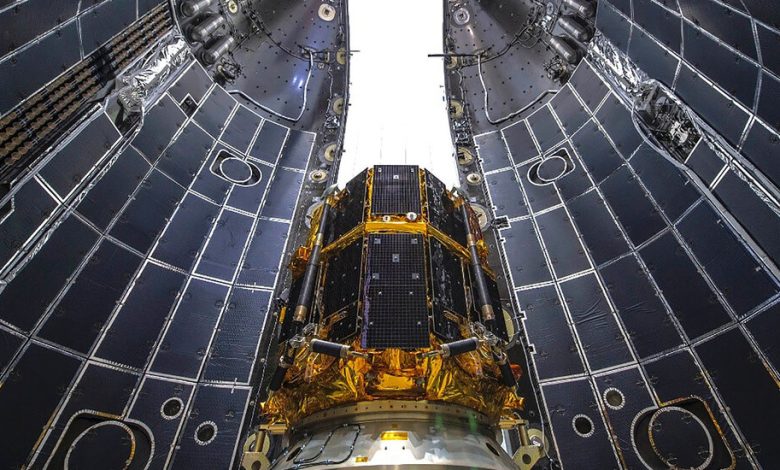Next Launch to the Moon: A Japanese Company’s Lunar Lander

Another day, another rocket launch by SpaceX, and another spacecraft going to the moon. All those seem commonplace these days.
SpaceX has already launched its Falcon 9 rocket more than 50 times this year. NASA’s Artemis I, an uncrewed test flight that is a precursor to future astronaut missions, is nearing its return to Earth after orbiting the moon,. CAPSTONE, a small NASA-sponsored CubeSat is still orbiting the moon after being launched in June. A robotic South Korean orbiter, Danuri, was launched to the moon in August.
But the lunar lander on top of the Falcon 9 rocket on the launchpad at Cape Canaveral, Fla., is not a NASA mission. Instead, known as M1, it is from a small Japanese company, Ispace. The payloads on M1 include a rover from the United Arab Emirates and a small two-wheeled Transformers-like robot for the Japanese space agency. If the launch goes off as planned on Sunday morning, you’ll have to wait until April to see if these robotic explorers make it, possibly becoming the first cargo successfully carried to the lunar surface by a private company.
When is the launch, and how can I watch it?
You’ll have to get up early on Sunday to see it: The launch is scheduled for 2:38 a.m. Eastern time (SpaceX postponed the launch earlier this month to complete additional checks of the rocket). SpaceX will start streaming coverage about 15 minutes before liftoff. Or you can watch it in the video player embedded above.
After the launch, Ispace will also provide a livestream on YouTube of the spacecraft’s separation from the rocket.
What is Ispace, and what is it sending to the moon?
The company started as one of the competitors for the Google Lunar X Prize, a competition that offered a $20 million prize for the first private spacecraft to land on the moon, travel 500 meters and send back video from the lunar surface.
At the time, the Japanese group, known as Team Hakuto, focused on developing a rover, and it was to rely on a competing team from India for the ride to the surface of the moon. If that had worked, the two rovers would have been racing to see which could travel the 500 meters first.
However, the Lunar X Prize expired before any of the teams made it to the launchpad. An Israeli competitor, SpaceIL, launched its craft in 2019, but its moon lander crashed on the lunar surface.
The group known as Team Hakuto evolved into Ispace, attracting sizable investment, and the company plans to launch a series of commercial moon landers in the coming years.
For Sunday’s mission, the payloads include the Rashid lunar rover from the Mohammed Bin Rashid Space Center in Dubai; a two-wheeled “transformable lunar robot” from JAXA, the Japanese space agency; a test module for a solid-state battery from NGK Spark Plug Company; an artificial intelligence flight computer; and 360-degree cameras from Canadensys Aerospace.
As a vestige of its Lunar X Prize heritage, it is also carrying a panel engraved with the names of people who provided crowdfunding support and a music disc with a song performed by the Japanese rock band Sakanaction.
The Japanese company’s lander is not the only passenger on the flight. A secondary payload on the Falcon 9 is a small NASA mission, Lunar Flashlight, which is to enter an elliptical orbit around the moon and use an infrared laser to probe the deep, dark craters at the moon’s polar regions.
Why will it take Ispace so long to get to the moon?
Much like some other recent moon missions, M1 is taking a circuitous, energy-efficient trip to the moon and will not land, in the Atlas Crater in the Northern Hemisphere of the moon, until late April. The fuel-efficient trajectory allows the mission to pack in more payload and carry less fuel.
What are the moon’s other recent visitors?
As part of the Artemis I mission, NASA’s Orion spacecraft traveled to, then orbited, the moon. It will return to Earth later on Sunday, with a splashdown into the Pacific Ocean.
A small NASA-financed mission called CAPSTONE also arrived recently to explore an orbit in which NASA plans to build a lunar outpost where astronauts will stop on the way to the moon.
And while it hasn’t arrived yet, the moon will get a third new visitor next month. Danuri, a South Korean space probe, was launched in August and is due to enter lunar orbit on Dec. 16. The spacecraft will help the development of technology for future Korean missions, and it also carries scientific instruments to study the moon’s chemical composition and magnetic field.
Are other companies attempting what Ispace is doing?
A NASA program called Commercial Lunar Payload Services, or CLPS, has been looking to send experiments to the surface of the moon. The first two missions, from Intuitive Machines of Houston and Astrobotic Technology of Pittsburgh, plan to launch next year after considerable delays. Intuitive Machines’ lander, which could be launched as early as March, could even beat Ispace to the moon because it’s using a quick six-day trajectory.
Because it is not an American company, Ispace could not directly participate in the NASA program. However, it is part of a team led by Draper Technologies of Cambridge, Mass., that has won a CLPS mission from NASA. That mission is scheduled to be launched in 2025.
